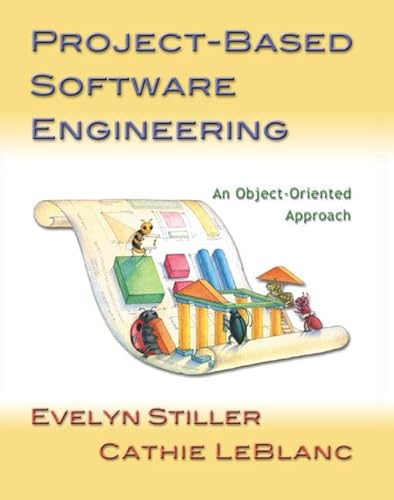
Synopsis
Project-Based Software Engineering is the first book to provide hands-on process and practice in software engineering essentials for the beginner. The book presents steps through the software development life cycle and two running case studies that develop as the steps are presented. Running parallel to the process presentation and case studies, the book supports a semester-long software development project. This book focuses on object-oriented software development, and supports the conceptualization, analysis, design and implementation of an object-oriented project. It is mostly language-independent, with necessary code examples in Java. A subset of UML is used, with the notation explained as needed to support the readers' work. Two running case studies a video game and a library check out system show the development of a software project. Both have sample deliverables and thus provide the reader with examples of the type of work readers are to create. This book is appropriate for readers looking to gain experience in project analysis, design implementation, and testing.
"synopsis" may belong to another edition of this title.
From the Back Cover
Project-Based Software Engineering is the first textbook to provide hands-on process and practice in software engineering essentials for the beginner, enabling students without experience to gain real-world practice and see first-hand the benefits of utilizing software engineering techniques. The book presents steps through the software development life cycle, which are then realized via two running case studies that follow through the conceptualization, analysis, design, and implementation stages of the process. These case studies, which show the deliverables for each stage, can be worked through by a small software development team. A full software development project is also included so students can apply their understanding of and experience with the various phases of the process.
Project-Based Software Engineering focuses on object-oriented software development, and is structured for this paradigm. It takes a mostly language-independent approach (necessary code examples are in Java) and uses a subset of the Unified Modeling Language (UML) to model the software, explaining the notation as needed to support the students' work. This book is written for students and professionals alike whose goal is to gain hands-on experience in software project analysis, design, implementation, and testing.
"About this title" may belong to another edition of this title.
Other Popular Editions of the Same Title
Search results for Project-Based Software Engineering: An Object-Oriented...
Project-Based Software Engineering: An Object-Oriented Approach
Seller: Orion Tech, Kingwood, TX, U.S.A.
paperback. Condition: Good. Seller Inventory # 020174225X-3-32112824
Project-Based Software Engineering : An Object-Oriented Approach
Seller: Better World Books, Mishawaka, IN, U.S.A.
Condition: Fine. 1st. Used book that is in almost brand-new condition. Seller Inventory # 14430752-75
Project-Based Software Engineering : An Object-Oriented Approach
Seller: Better World Books Ltd, Dunfermline, United Kingdom
Condition: Very Good. 1st. Ships from the UK. Former library book; may include library markings. Used book that is in excellent condition. May show signs of wear or have minor defects. Seller Inventory # GRP28611945
Buy Used
Ships from United Kingdom to U.S.A.
Quantity: 1 available
Project-Based Software Engineering: An Object-Oriented Approach
Seller: Anybook.com, Lincoln, United Kingdom
Condition: Good. This is an ex-library book and may have the usual library/used-book markings inside.This book has soft covers. In good all round condition. Please note the Image in this listing is a stock photo and may not match the covers of the actual item,700grams, ISBN:9780201742251. Seller Inventory # 9512027
Buy Used
Ships from United Kingdom to U.S.A.
Quantity: 1 available
Project-Based Software Engineering: An Object-Oriented Approach
Seller: WorldofBooks, Goring-By-Sea, WS, United Kingdom
Hardback. Condition: Very Good. The book has been read, but is in excellent condition. Pages are intact and not marred by notes or highlighting. The spine remains undamaged. Seller Inventory # GOR002852762
Buy Used
Ships from United Kingdom to U.S.A.
Quantity: 1 available
Project Based Software Engineering: An Object-Oriented Approach
Seller: Greener Books, London, United Kingdom
Paperback. Condition: Used; Very Good. **SHIPPED FROM UK** We believe you will be completely satisfied with our quick and reliable service. All orders are dispatched as swiftly as possible! Buy with confidence! Greener Books. Seller Inventory # 4982906
Buy Used
Ships from United Kingdom to U.S.A.
Quantity: 1 available
Project-Based Software Engineering: An Object-Oriented Approach [Taschenbuch].
Seller: unifachbuch e.K., Köln, NRW, Germany
Taschenbuch. Condition: Neu. Gebraucht - Wie neu Unbenutzt. Schnelle Lieferung, Kartonverpackung. Abzugsfähige Rechnung. Bei Mehrfachbestellung werden die Versandkosten anteilig erstattet. -Project-Based Software Engineering is the first book to provide hands-on process and practice in software engineering essentials for the beginner. The book presents steps through the software development life cycle and two running case studies that develop as the steps are presented. Running parallel to the process presentation and case studies, the book supports a semester-long software development project. This book focuses on object-oriented software development, and supports the conceptualization, analysis, design and implementation of an object-oriented project. It is mostly language-independent, with necessary code examples in Java. A subset of UML is used, with the notation explained as needed to support the readers' work. Two running case studies a video game and a library check out system show the development of a software project. Both have sample deliverables and thus provide the reader with examples of the type of work readers are to create. This book is appropriate for readers looking to gain experience in project analysis, design implementation, and testing. 400 pp. Englisch. Seller Inventory # INF1000039528
Buy New
Ships from Germany to U.S.A.
Quantity: 1 available
Project-Based Software Engineering: An Object-Oriented Approach
Seller: BookHolders, Towson, MD, U.S.A.
Condition: Good. [ No Hassle 30 Day Returns ][ Ships Daily ] [ Underlining/Highlighting: NONE ] [ Writing: NONE ] [ Edition: first ] Publisher: Addison Wesley Pub Date: 7/27/2001 Binding: Paperback Pages: 400 first edition. Seller Inventory # 6911526

